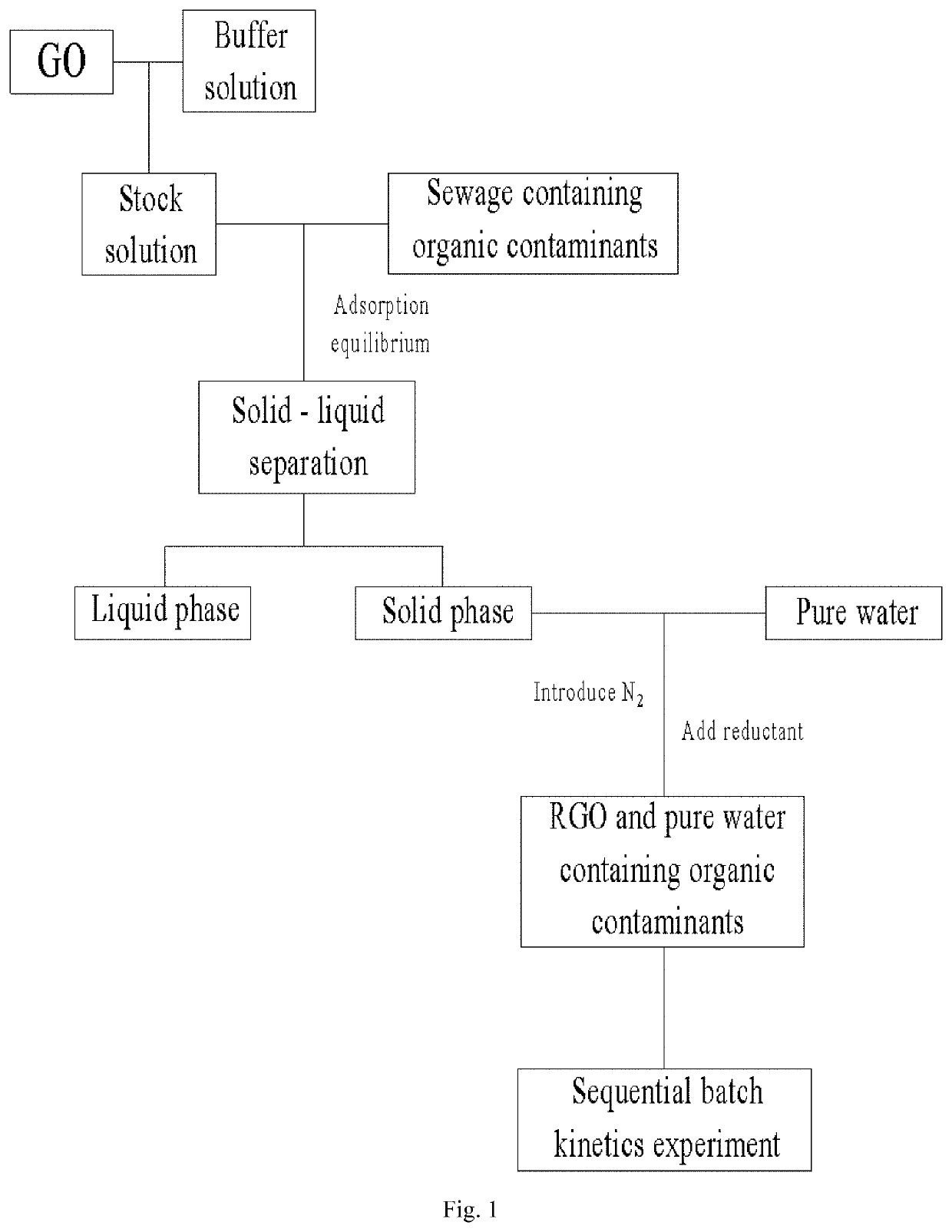Method for initiating a graphene oxide through reduction by a reductant to controllably release organic compounds
- Summary
- Abstract
- Description
- Claims
- Application Information
AI Technical Summary
Benefits of technology
Problems solved by technology
Method used
Image
Examples
example 1
[0038]In the present embodiment, a sewage containing 4-chlorophenol is specifically described as the subject. As shown in FIG. 1, the method for initiating a graphene oxide through reduction by a reductant to controllably release organic compounds comprises the following steps:
[0039](1) the graphene oxide was prepared according to the Hummer synthesis method, and the graphene oxide was dispersed in an aqueous solution to obtain a graphene oxide mother solution;
[0040](2) the above graphene oxide mother solution was mixed with 50 mM Tris-HCl, pH 7.5, and the mass of the graphene oxide and Tris-HCl was 1:9 to prepare a stock solution, which was prepared and stored at 25° C. for use;
[0041](3) simulating an actual sewage water sample, 4-chlorophenol (chemically pure) was added to a tap water according to the mass ratio of the organic contaminants and the stock solution of 1:4.3×105 to formulate a sewage sample of a concentration of 18.4 μmol L−1 for use;
[0042](4) under stirring condition...
example 2
[0046]The influence of different mass ratios of the graphene oxide and the buffer solution on the adsorption distribution coefficient (Kd) of graphene oxide was studied:
[0047]Using Example 1 as a reference, 4 control groups were set up, each with 3 in parallel. The rest conditions were the same. The mass ratio and adsorption rate of the graphene oxide and Tris-HCl were shown in Table 1 respectively:
TABLE 1Mass ratios of graphene oxide and Tris - HCl solutions andadsorption distribution coefficient (Kd) for each groupGroupmass ratioKd (L / kg)Example 11:9 96000 ± 6000Comparative Example 1 1:8.498000 ± 5000Comparative Example 21:1095000 ± 8000Comparative Example 3 1:5.685000 ± 6000Comparative Example 41:2096000 ± 6000
[0048]Test results: The results of Comparative Example 1 and Comparative Example 2 are substantially the same as that of Example 1, and there is no significant difference. The results of Comparative Example 3 and Comparative Example 4 show some differences. Among them, the ...
example 3
[0050]The effect of pH of the solution on the adsorption distribution coefficient (Kd) of GO was studied:
[0051]Using Example 1 as a reference, 3 control groups were set up, each with 3 in parallel, the rest of the conditions were the same, and the effect of pH of the solution to the adsorption of 4-chlorophenol on graphene oxide were shown in Table 2 respectively:
TABLE 2Effect of pH of the solution on the adsorption distributioncoefficient (Kd) of 4 - chlorophenol on GOGrouppHKd (L / kg)Example 17.596000 ± 6000 Comparative Example 15.524000 ± 2000 Comparative Example 26.534000 ± 10000Comparative Example 38.550000 ± 10000
[0052]Results: The results of Comparative Example 1, Comparative Example 2, Comparative Example 3 and Example 1 are quite different. Among them, the adsorption distribution coefficient of 4-chlorophenol on GO in Comparative Example 3 is decreased by about 47.92% compared to Example 1, the adsorption distribution coefficient in Comparative Example 2 is decreased by abou...
PUM
| Property | Measurement | Unit |
|---|---|---|
| Length | aaaaa | aaaaa |
| Molar density | aaaaa | aaaaa |
| Time | aaaaa | aaaaa |
Abstract
Description
Claims
Application Information
 Login to View More
Login to View More - R&D
- Intellectual Property
- Life Sciences
- Materials
- Tech Scout
- Unparalleled Data Quality
- Higher Quality Content
- 60% Fewer Hallucinations
Browse by: Latest US Patents, China's latest patents, Technical Efficacy Thesaurus, Application Domain, Technology Topic, Popular Technical Reports.
© 2025 PatSnap. All rights reserved.Legal|Privacy policy|Modern Slavery Act Transparency Statement|Sitemap|About US| Contact US: help@patsnap.com



